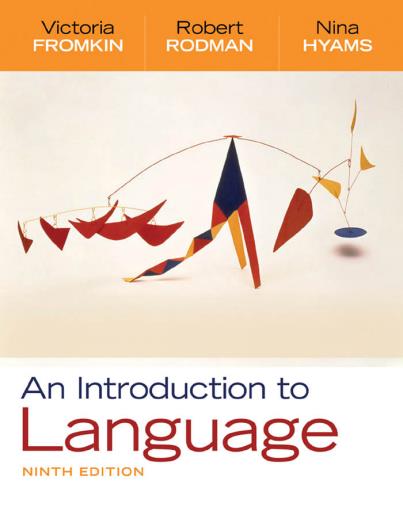
Victoria Robert Nina FROMKIN RODMAN HYAMS An Introduction to Language NINTH EDITION
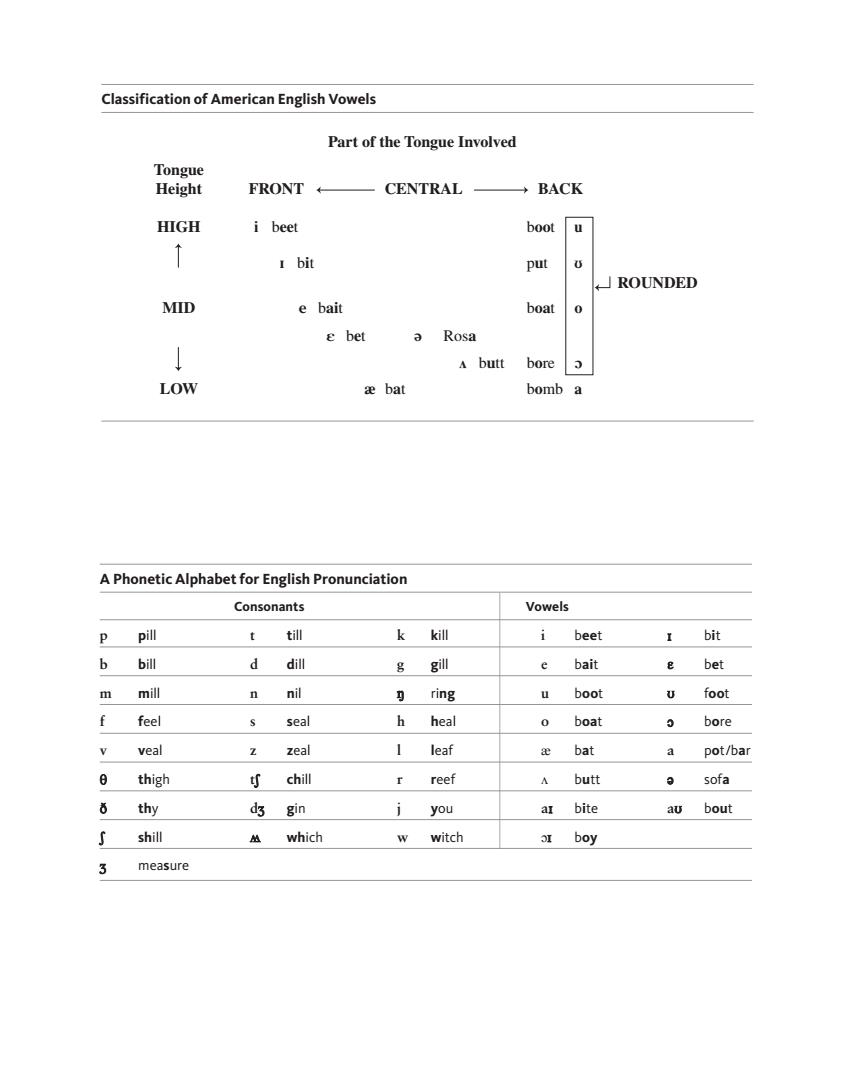
Classification of American English Vowels Part of the Tongue Involved Tongue Height FRONT CENTRAL BACK HIGH ibeet boot u ↑ I bit put 0 ROUNDED MID e bait boat 0 e bet a Rosa 1 A butt bore LOW ae bat bomb a A Phonetic Alphabet for English Pronunciation Consonants Vowels pill t ti训 k kill ibeet bit b bill d dill g gill e bait e bet m mill n nil ring u boot 心 foot f feel s seal h heal 0 boat 0 bore v veal z zeal 1 leaf a bat a pot/bar 0 thigh t了chil reef A butt sofa 8 thy d3 gin you bite aU bout ∫ shill which w witch oI boy 3 measure
Classification of American English Vowels A Phonetic Alphabet for English Pronunciation Tongue Height HIGH i u o beet boot I Á bit put e bait boat Ø butt bore O œ bat bomb a ” bet Ros E a MID LOW ROUNDED Part of the Tongue Involved FRONT CENTRAL BACK Consonants Vowels p pill t till k kill i beet ɪ bit b bill d dill g gill e bait ɛ bet m mill n nil ŋ ring u boot ʊ foot f feel s seal h heal o boat ɔ bore v veal z zeal l leaf æ bat a pot/bar θ thigh tʃ chill r reef ʌ butt ə sofa ð thy dʒ gin j you aɪ bite aʊ bout ʃ shill ʍ which w witch ɔɪ boy ʒ measure
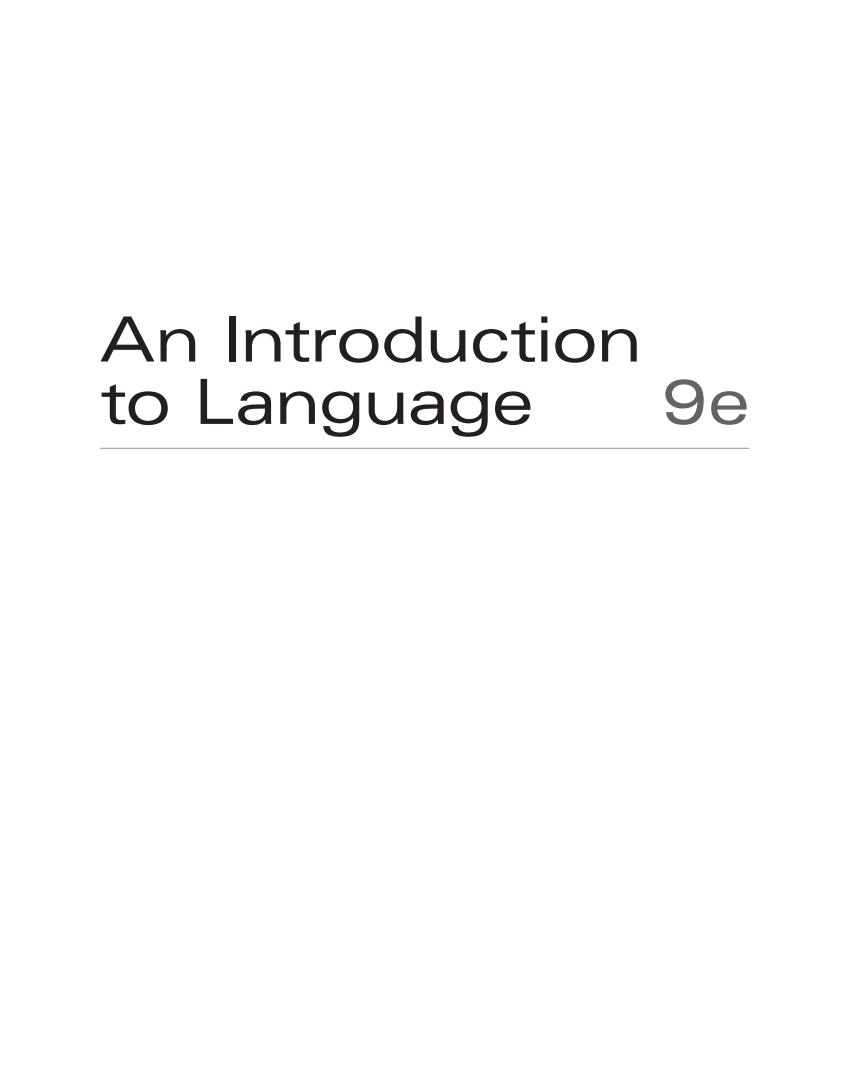
An Introduction to Language 9e
An Introduction to Language 9e
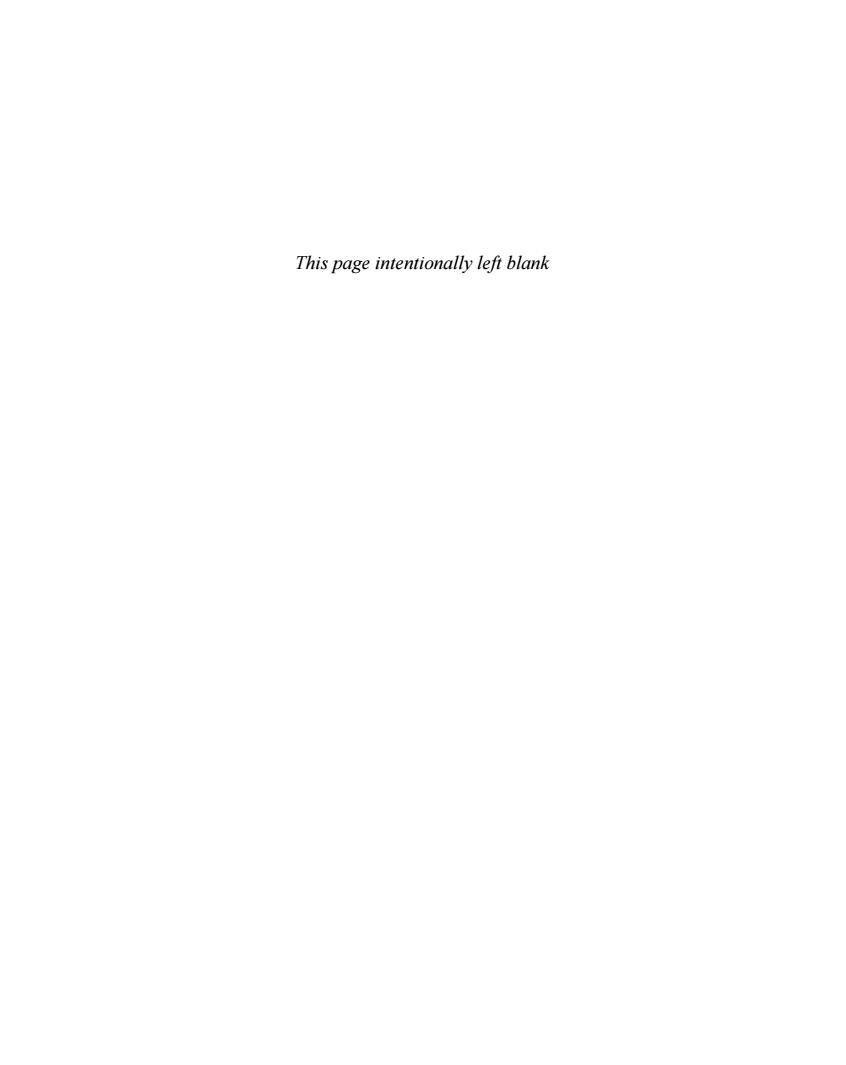
This page intentionally left blank
This page intentionally left blank

An Introduction to Language 9e VICTORIA FROMKIN Late,University of California,Los Angeles ROBERT RODMAN North Carolina State University,Raleigh NINA HYAMS University of California,Los Angeles WAOSNORTE Australia.Canada.Mexico.Brazil.Singapore.Spain.United Kingdom.United States
VICTORIA FROMKIN Late, University of California, Los Angeles ROBERT RODMAN North Carolina State University, Raleigh NINA HYAMS University of California, Los Angeles An Introduction to Language 9e Australia • Canada • Mexico • Brazil • Singapore • Spain • United Kingdom • United States
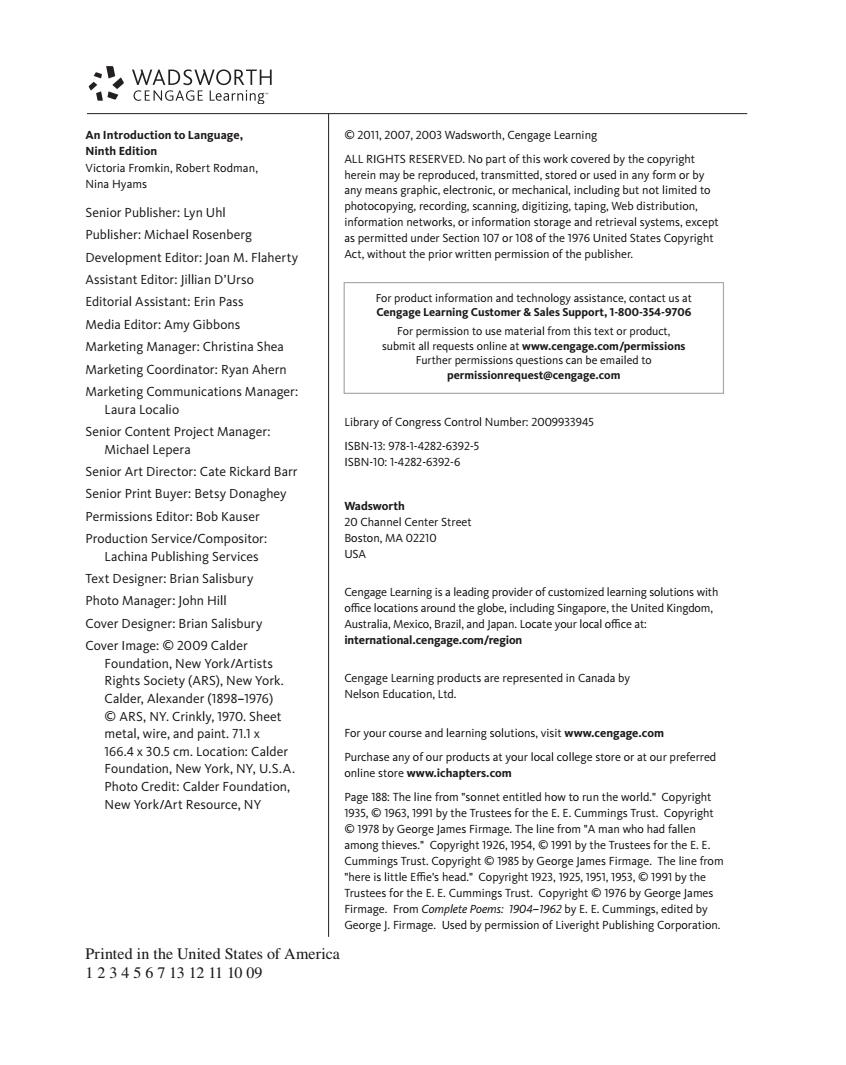
WADSWORTH CENGAGE Learning An Introduction to Language, 2011,2007,2003 Wadsworth,Cengage Learning Ninth Edition ALL RIGHTS RESERVED.No part of this work covered by the copyright Victoria Fromkin,Robert Rodman, Nina Hyams herein may be reproduced,transmitted,stored or used in any form or by any means graphic,electronic,or mechanical,including but not limited to Senior Publisher:Lyn Uhl photocopying.recording,scanning.digitizing,taping,Web distribution, information networks,or information storage and retrieval systems,except Publisher:Michael Rosenberg as permitted under Section 107 or 108 of the 1976 United States Copyright Development Editor:Joan M.Flaherty Act,without the prior written permission of the publisher. Assistant Editor:Jillian D'Urso Editorial Assistant:Erin Pass For product information and technology assistance,contact us at Cengage Learning Customer Sales Support,1-800-354-9706 Media Editor:Amy Gibbons For permission to use material from this text or product, Marketing Manager:Christina Shea submit all requests online at www.cengage.com/permissions Further permissions questions can be emailed to Marketing Coordinator:Ryan Ahern permissionrequest@cengage.com Marketing Communications Manager: Laura Localio Senior Content Project Manager: Library of Congress Control Number:2009933945 Michael Lepera 15BN-13:978-1-4282-6392-5 1sBN-10:1-4282-6392-6 Senior Art Director:Cate Rickard Barr Senior Print Buyer:Betsy Donaghey Wadsworth Permissions Editor:Bob Kauser 20 Channel Center Street Production Service/Compositor: Boston,MA 02210 Lachina Publishing Services USA Text Designer:Brian Salisbury Photo Manager:John Hill Cengage Learning is a leading provider of customized learning solutions with office locations around the globe,incuding Singapore,the United Kingdom, Cover Designer:Brian Salisbury Australia,Mexico,Brazil,and Japan.Locate your local office at: Cover Image:2009 Calder international.cengage.com/region Foundation,New York/Artists Rights Society(ARS),New York. Cengage Learning products are represented in Canada by Calder,Alexander (1898-1976) Nelson Education,Ltd. ARS,NY.Crinkly,1970.Sheet metal,wire,and paint.71.1 x For your course and learning solutions,visit www.cengage.com 166.4 x 30.5 cm.Location:Calder Purchase any of our products at your local college store or at our preferred Foundation,New York.NY.U.S.A online store www.ichapters.com Photo Credit:Calder Foundation, New York/Art Resource,NY Page 188:The line from"sonnet entitled how to run the world."Copyright 1935,1963,1991 by the Trustees for the E.E.Cummings Trust.Copyright 1978 by George James Firmage.The line from"A man who had fallen among thieves."Copyright 1926,1954,1991 by the Trustees for the E.E. Cummings Trust.Copyright C 1985 by George James Firmage.The line from "here is little Effie's head."Copyright 1923,1925,1951,1953.1991 by the Trustees for the E.E.Cummings Trust.Copyright 1976 by George James Firmage.From Complete Poems:1904-1962 by E.E.Cummings,edited by George J.Firmage.Used by permission of Liveright Publishing Corporation. Printed in the United States of America 12345671312111009
© 2011, 2007, 2003 Wadsworth, Cengage Learning ALL RIGHTS RESERVED. No part of this work covered by the copyright herein may be reproduced, transmitted, stored or used in any form or by any means graphic, electronic, or mechanical, including but not limited to photocopying, recording, scanning, digitizing, taping, Web distribution, information networks, or information storage and retrieval systems, except as permitted under Section 107 or 108 of the 1976 United States Copyright Act, without the prior written permission of the publisher. Library of Congress Control Number: 2009933945 ISBN-13: 978-1-4282-6392-5 ISBN-10: 1-4282-6392-6 Wadsworth 20 Channel Center Street Boston, MA 02210 USA Cengage Learning is a leading provider of customized learning solutions with offi ce locations around the globe, including Singapore, the United Kingdom, Australia, Mexico, Brazil, and Japan. Locate your local offi ce at: international.cengage.com/region Cengage Learning products are represented in Canada by Nelson Education, Ltd. For your course and learning solutions, visit www.cengage.com Purchase any of our products at your local college store or at our preferred online store www.ichapters.com Page 188: The line from "sonnet entitled how to run the world." Copyright 1935, © 1963, 1991 by the Trustees for the E. E. Cummings Trust. Copyright © 1978 by George James Firmage. The line from "A man who had fallen among thieves." Copyright 1926, 1954, © 1991 by the Trustees for the E. E. Cummings Trust. Copyright © 1985 by George James Firmage. The line from "here is little Effi e's head." Copyright 1923, 1925, 1951, 1953, © 1991 by the Trustees for the E. E. Cummings Trust. Copyright © 1976 by George James Firmage. From Complete Poems: 1904–1962 by E. E. Cummings, edited by George J. Firmage. Used by permission of Liveright Publishing Corporation. An Introduction to Language, Ninth Edition Victoria Fromkin, Robert Rodman, Nina Hyams Senior Publisher: Lyn Uhl Publisher: Michael Rosenberg Development Editor: Joan M. Flaherty Assistant Editor: Jillian D’Urso Editorial Assistant: Erin Pass Media Editor: Amy Gibbons Marketing Manager: Christina Shea Marketing Coordinator: Ryan Ahern Marketing Communications Manager: Laura Localio Senior Content Project Manager: Michael Lepera Senior Art Director: Cate Rickard Barr Senior Print Buyer: Betsy Donaghey Permissions Editor: Bob Kauser Production Service/Compositor: Lachina Publishing Services Text Designer: Brian Salisbury Photo Manager: John Hill Cover Designer: Brian Salisbury Cover Image: © 2009 Calder Foundation, New York/Artists Rights Society (ARS), New York. Calder, Alexander (1898–1976) © ARS, NY. Crinkly, 1970. Sheet metal, wire, and paint. 71.1 x 166.4 x 30.5 cm. Location: Calder Foundation, New York, NY, U.S.A. Photo Credit: Calder Foundation, New York/Art Resource, NY Printed in the United States of America 1 2 3 4 5 6 7 13 12 11 10 09 For product information and technology assistance, contact us at Cengage Learning Customer & Sales Support, 1-800-354-9706 For permission to use material from this text or product, submit all requests online at www.cengage.com/permissions Further permissions questions can be emailed to permissionrequest@cengage.com
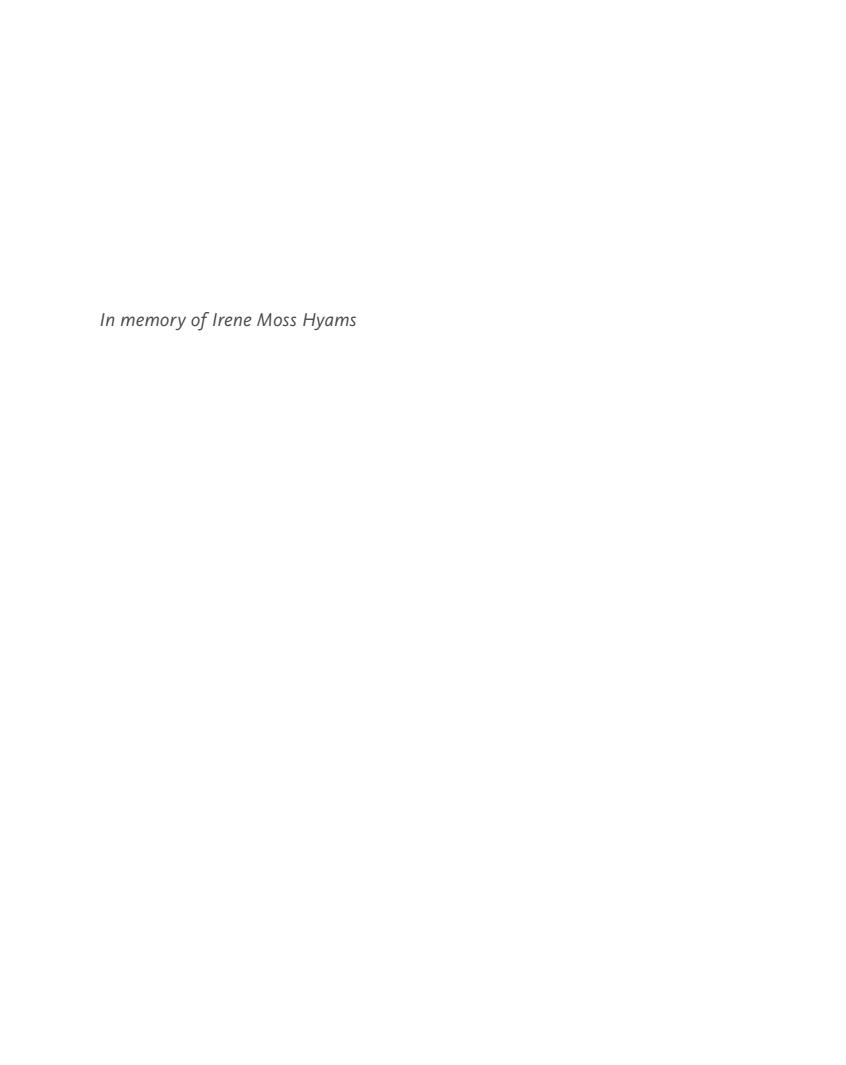
In memory of lrene Moss Hyams
In memory of Irene Moss Hyams

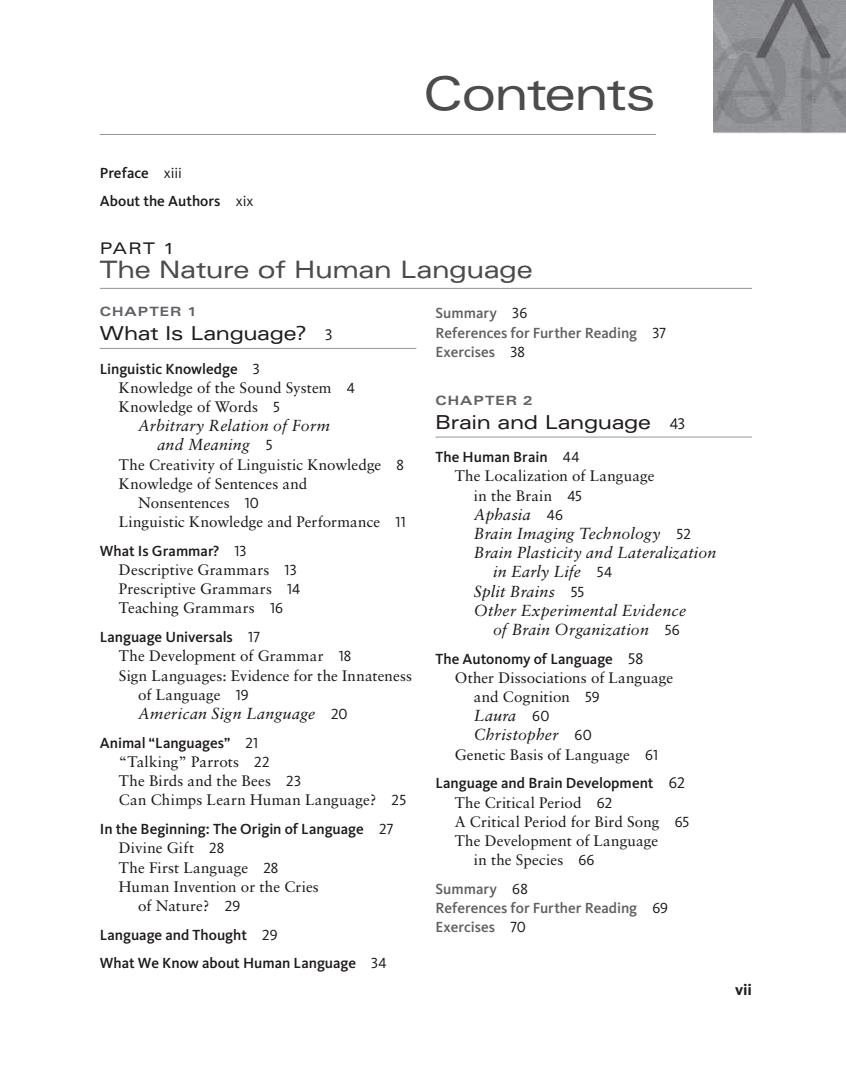
Contents Preface xiii About the Authors xix PART 1 The Nature of Human Language CHAPTER 1 Summary 36 What Is Language?3 References for Further Reading 37 Exercises 38 Linguistic Knowledge 3 Knowledge of the Sound System 4 Knowledge of Words 5 CHAPTER 2 Arbitrary Relation of Form Brain and Language 43 and Meaning 5 The Creativity of Linguistic Knowledge 8 The Human Brain 44 Knowledge of Sentences and The Localization of Language Nonsentences 10 in the Brain 45 Linguistic Knowledge and Performance 11 Aphasia 46 Brain Imaging Technology 52 What Is Grammar?13 Brain Plasticity and Lateralization Descriptive Grammars 13 in Early Life 54 Prescriptive Grammars 14 Split Brains 55 Teaching Grammars 16 Other Experimental Evidence Language Universals 17 of Brain Organization 56 The Development of Grammar 18 The Autonomy of Language 58 Sign Languages:Evidence for the Innateness Other Dissociations of Language of Language 19 and Cognition 59 American Sign Language 20 Laura 60 Animal“Languages”21 Christopher 60 “Talking”Parrots22 Genetic Basis of Language 61 The Birds and the Bees 23 Language and Brain Development 62 Can Chimps Learn Human Language?25 The Critical Period 62 In the Beginning:The Origin of Language 27 A Critical Period for Bird Song 65 Divine Gift 28 The Development of Language The First Language 28 in the Species 66 Human Invention or the Cries Summary 68 of Nature?29 References for Further Reading 69 Language and Thought 29 Exercises 70 What We Know about Human Language 34 vii
vii CHAPTER 1 What Is Language? 3 Linguistic Knowledge 3 Knowledge of the Sound System 4 Knowledge of Words 5 Arbitrary Relation of Form and Meaning 5 The Creativity of Linguistic Knowledge 8 Knowledge of Sentences and Nonsentences 10 Linguistic Knowledge and Performance 11 What Is Grammar? 13 Descriptive Grammars 13 Prescriptive Grammars 14 Teaching Grammars 16 Language Universals 17 The Development of Grammar 18 Sign Languages: Evidence for the Innateness of Language 19 American Sign Language 20 Animal “Languages” 21 “Talking” Parrots 22 The Birds and the Bees 23 Can Chimps Learn Human Language? 25 In the Beginning: The Origin of Language 27 Divine Gift 28 The First Language 28 Human Invention or the Cries of Nature? 29 Language and Thought 29 What We Know about Human Language 34 PART 1 The Nature of Human Language Preface xiii About the Authors xix Contents Summary 36 References for Further Reading 37 Exercises 38 CHAPTER 2 Brain and Language 43 The Human Brain 44 The Localization of Language in the Brain 45 Aphasia 46 Brain Imaging Technology 52 Brain Plasticity and Lateralization in Early Life 54 Split Brains 55 Other Experimental Evidence of Brain Organization 56 The Autonomy of Language 58 Other Dissociations of Language and Cognition 59 Laura 60 Christopher 60 Genetic Basis of Language 61 Language and Brain Development 62 The Critical Period 62 A Critical Period for Bird Song 65 The Development of Language in the Species 66 Summary 68 References for Further Reading 69 Exercises 70

viii CONTENTS PART 2 Grammatical Aspects of Language CHAPTER 3 Heads and Complements 142 Morphology:The Words Selection 143 of Language 76 What Heads the Sentence 145 Structural Ambiguities 149 Dictionaries 78 More Structures 151 Content Words and Function Words 78 Sentence Relatedness 155 Transformational Rules 155 Morphemes:The Minimal Units of Meaning 80 Bound and Free Morphemes 83 The Structural Dependency Prefixes and Suffixes 83 of Rules 157 Infixes 85 Further Syntactic Dependencies 160 Circumfixes 85 UG Principles and Parameters 164 Roots and Stems 86 Bound Roots 87 Sign Language Syntax 167 Rules of Word Formation 87 Summary 168 Derivational Morphology 88 References for Further Reading 169 Inflectional Morphology 90 Exercises 170 The Hierarchical Structure of Words 93 Rule Productivity 96 CHAPTER 5 Exceptions and Suppletions 98 The Meaning Lexical Gaps 99 of Language 179 Other Morphological Processes 100 Back-Formations 100 What Speakers Know about Sentence Compounds 100 Meaning 180 “Pullet Surprises”lO3 Truth 180 Sign Language Morphology 103 Entailment and Related Notions 181 Ambiguity 182 Morphological Analysis:Identifying Morphemes 104 Compositional Semantics 184 Semantic Rules 184 Summary 107 Semantic Rule I 185 References for Further Reading 108 Semantic Rule II 185 Exercises 108 When Compositionality Goes Awry 186 Anomaly 187 CHAPTER 4 Metaphor 189 Syntax:The Sentence Idioms 190 Patterns of Language 117 Lexical Semantics(Word Meanings)192 Theories of Word Meaning 193 What the Syntax Rules Do 118 Reference 194 What Grammaticality Is Not Based On 122 Sense 195 Sentence Structure 123 Lexical Relations 196 Constituents and Constituency Tests 124 Semantic Features 199 Syntactic Categories 126 Evidence for Semantic Features 200 Phrase Structure Trees and Rules 129 Semantic Features and Grammar 200
viii CONTENTS Heads and Complements 142 Selection 143 What Heads the Sentence 145 Structural Ambiguities 149 More Structures 151 Sentence Relatedness 155 Transformational Rules 155 The Structural Dependency of Rules 157 Further Syntactic Dependencies 160 UG Principles and Parameters 164 Sign Language Syntax 167 Summary 168 References for Further Reading 169 Exercises 170 CHAPTER 5 The Meaning of Language 179 What Speakers Know about Sentence Meaning 180 Truth 180 Entailment and Related Notions 181 Ambiguity 182 Compositional Semantics 184 Semantic Rules 184 Semantic Rule I 185 Semantic Rule II 185 When Compositionality Goes Awry 186 Anomaly 187 Metaphor 189 Idioms 190 Lexical Semantics (Word Meanings) 192 Theories of Word Meaning 193 Reference 194 Sense 195 Lexical Relations 196 Semantic Features 199 Evidence for Semantic Features 200 Semantic Features and Grammar 200 PART 2 Grammatical Aspects of Language CHAPTER 3 Morphology: The Words of Language 76 Dictionaries 78 Content Words and Function Words 78 Morphemes: The Minimal Units of Meaning 80 Bound and Free Morphemes 83 Prefixes and Suffixes 83 Infixes 85 Circumfixes 85 Roots and Stems 86 Bound Roots 87 Rules of Word Formation 87 Derivational Morphology 88 Inflectional Morphology 90 The Hierarchical Structure of Words 93 Rule Productivity 96 Exceptions and Suppletions 98 Lexical Gaps 99 Other Morphological Processes 100 Back-Formations 100 Compounds 100 “Pullet Surprises” 103 Sign Language Morphology 103 Morphological Analysis: Identifying Morphemes 104 Summary 107 References for Further Reading 108 Exercises 108 CHAPTER 4 Syntax: The Sentence Patterns of Language 117 What the Syntax Rules Do 118 What Grammaticality Is Not Based On 122 Sentence Structure 123 Constituents and Constituency Tests 124 Syntactic Categories 126 Phrase Structure Trees and Rules 129